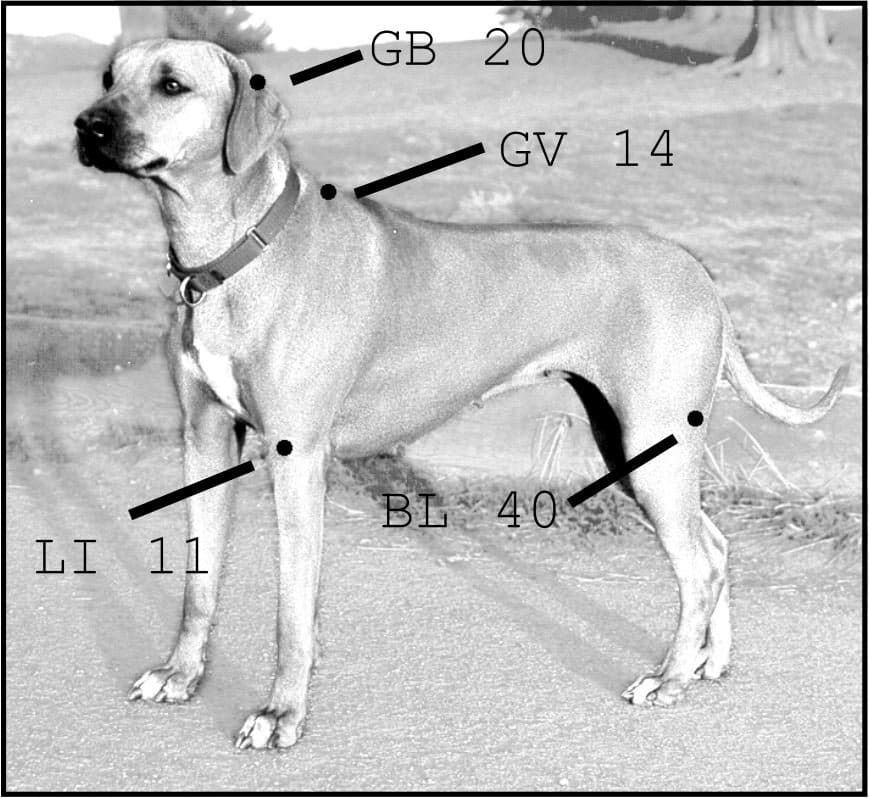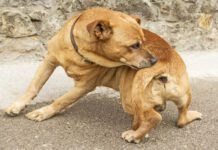[Updated January 30, 2019]
Upon waking up one morning many years ago, I greeted Mandy, my six-year-old tri-color Collie, who slept beside my bed. As I leaned over to stroke her luxurious black coat, I gasped. There was an angry, oozing sore the size of a grapefruit on the outside of her right hind leg. It was cherry red, inflamed, and looked incredibly painful. I was horrified. I worked at a humane society at the time. This looked like the kind of wound we would investigate an irresponsible owner for, for not providing proper care and attention! I was sure it hadn’t been there the night before. What had happened to my dog? I rushed her to my veterinarian.
Mandy had a “hot spot,” due to, according to my vet, a flea allergy. I felt terrible. I was a bad dog owner. Even when my veterinarian assured me that it didn’t mean Mandy was infested with fleas, that a single flea can trigger an allergic reaction in a flea-sensitive dog, I still felt like I had somehow neglected her.
We treated the wound, it healed without complication, I tried to improve my flea-control methods, and Mandy never had a recurrence of the ugly condition. We were lucky. It’s not always so easy to win the hot-spot battle.

What is a Hot Spot?
A hot spot, according to Terry G. Spencer, DVM, of the Animal Health Center in Salinas, California, is known formally as “acute moist pyoderma,” and is a signal of an underlying skin disorder. The most common disorder is a flea allergy, but hot spots are also linked to other conditions such as food allergies, poor nutrition, and thyroid disease.
Acute moist pyoderma is caused by the microorganism Staphylococcus intermedius. The organism is commonly found on the skin, and opportunistically takes advantage when the integrity of the skin is compromised by some underlying disorder. The skin is an organ whose vitally important function is to form a protective covering for the rest of the body, preventing the entry of foreign organisms that can infect and destroy the other organ systems. It’s our dog’s primary armor against any kind of bad bug. (And ours!)
When the staph. organism invades the skin at a weakened point (such as a flea bite in an allergic dog) it produces endotoxins that are destructive to skin cells. The body’s immune system kicks into high gear, sending an army of mast cells, histamines and other defensive bodies to the site of the hot spot. As the ensuing battle rages, the damage spreads, killing and consuming the skin in the process. The red angry appearance of a hot spot is not simply a sign of irritated skin. The skin is actually gone.
“A hot spot is a critical medical emergency similar to the skin loss of a burn victim,” says Dr. Spencer. “It can occur within a few hours, is intensely itchy and painful, and can progress to life-threatening if not treated. I have seen lesions grow from the size of a quarter to baseball-size within hours, and I have seen dogs with their entire sides sloughed away by this condition.”
Dr. Spencer received her degree in veterinary medicine from Colorado State University in 1995, and worked at several California veterinary clinics prior to opening her Animal Health Center in 1998. She utilizes veterinary orthopedic manipulation, works closely with a human chiropractor who is certified in veterinary chiropractic, and is in training to receive her veterinary acupuncture certificate. She routinely integrates complementary modalities into her treatment protocols and is a firm believer in the holistic approach to veterinary care. Despite her strong interest and belief in complementary medicines, she treats hot spots traditionally because of the severity of the condition. Once the crisis is resolved she then uses a more natural approach to prevent further hot spots.
Traditional Treatment for Hot Spots on Dogs
The standard veterinary treatment, according to Dr. Spencer, starts with clipping the hair around the affected area. The staph. organism is characterized by an oozing serum that congeals and mats the surrounding fur. Clipping makes it easier to treat the wound and keep it clean. Then the area is scrubbed with a disinfectant.
“It is important,” she cautions, “to use a disinfectant that is antiseptic (to kill the staph. and any other invading organism) but not caustic. I usually sedate the dog for this procedure because the hot spot is so intensely painful. Then I scrub with Chlorhexaderm or Betadine. Products like alcohol and peroxide must be avoided at all costs – they are extremely painful to an already excruciating wound, and peroxide will cause even more damage to the skin.”
After scrubbing the area, Dr. Spencer recommends application of a topical antiseptic steroid spray such as Dermacool or Gentocin.
“It is critically important to halt the progression of damage as quickly as possible,” she says. “Until we kill the staph. organisms and calm the hyper-reacting immune system the skin will continue to be eaten away. You can use a more natural approach with an oatmeal spray, but you run the risk of letting the infection get out of control. I prefer to use emergency measures to halt the damage. Then I’ll talk to the client about how to improve the overall health of the dog holistically in order to minimize the chance of recurrence.”
The Cortisone Controversy
There is no question that steroids can do nasty things to our canine friends. Dogs are very sensitive to steroids. The powerful drug suppresses the immune system, which leaves the patient vulnerable to other problems that run the continuum from mild to serious – from a simple bladder infection to the potential for onset of diabetes.
Use of steroids can also be damaging to the adrenal system. Adrenal glands secrete steroids, and when these are administered medically it sends a signal to the adrenal glands to stop production. This can sometimes totally shut down the body’s production of steroids. Steroids also cause our dogs to pant more, drink more, urinate and eat more, and can cause subsequent problems with incontinence and weight gain.
Dr. Spencer thinks steroids are a good thing to avoid unless they are absolutely necessary. In her opinion, hot spots make the use of steroids absolutely necessary.
“I do use steroids topically for hot spots, and I may give one injection of a short-acting steroid for stubborn cases, but,” she adds, “I don’t give oral steroids. If an owner doesn’t give all the pills and keeps them in the cupboard, she may be too tempted to pop a few into her dog’s mouth the next time he’s a little itchy. This is a good way to get into trouble with steroids.”
Other holistic practitioners we queried were less enthusiastic – and even rather condemning – about even sparing use of steroids for hot spots. Steroids do effect quick healing, but at a cost; they act in a suppressive manner, rather than supporting the body’s homeostasis, or natural return to balance.
Holistic Hot Spot Prevention
Once she has resolved the emergency through aggressive intervention, Dr. Spencer reverts to her holistic bias.
“The hot spot is just a symptom of an greater, underlying problem,” she reiterates. “Flea hypersensitivity is the most common cause, but there are others. Contact dermatitis can cause the condition. For example, people think tea tree oil is good for skin problems, but some dogs are highly allergic to it. I have seen a number of hot spots caused by contact with strong concentrations of tea tree oil. Also cedar allergies – many dogs are allergic to the cedar chips that are contained in some dog beds. Generalized allergies – food, pollens, anything that compromises the skin and the immune system – can provide the environment for the staph. organism to take hold. The constantly ‘itchy dog’ is the most likely victim for recurring hot spots.”
Dr. Spencer’s answers to the prevention question are simple: Use good flea control. Provide excellent nutrition. Identify allergens and reduce exposure. Maintain good grooming practices. Look for (and treat) signs of anything that might be suppressing the immune system, such as low thyroid. Do everything you would otherwise do to keep your dog in the peak of health. Healthy dogs are not likely to suffer from hot spots.
Flea sensitivity truly is the number one cause of hot spots. Regular flea combing, vacuuming, diatomaceous earth and nematodes are just some of the non-toxic, natural methods available for controlling those pesky bloodsuckers that can send out an open invitation for a staph. invasion.
Good nutrition not only aids in effective flea control, it also strengthens the body’s immune system, reducing the likelihood of allergy problems. The Omega 6 and Omega 3 fatty acids, given in the proper ratio (5:1), have been shown to fight inflammation and to help promote healthy skin. Speaking of healthy skin and coat, keeping your dog well-groomed – no oily, dirty skin – will also help stave off the staph.
Overvaccination is now suspect in canine skin allergies as well, so you might want to talk to your veterinarian about revisiting your dog’s vaccine schedule with an eye toward reducing the number of booster shots she gets. And, just like it does for us, exercise contributes to our dogs’ overall good heath and condition. If your pooch is a couch potato, it might behoove both of you to add a 20 to 30-minute aerobic hike up the hill to your daily routine.
The holistic philosophy says that organisms function as complete units that cannot be reduced to the sum of their parts. If your dog gets a hot spot, by all means treat the “part,” but then be sure to look beyond the immediate emergency to find the source of the problem. With hot spots, as with so many other health issues, if the complete unit is healthy it follows that the parts will also be healthy.
Holistic Help For Hot Spots
Some skin problems are caused by specific deficiencies including vitamins A, E, C, or zinc. For any dog with skin problems, we suggest using a daily multiple vitamin and mineral supplement, and additional vitamin C.
A thorough but simple discussion of how food allergies can trigger hot spots can be found in Dr. Donald R. Strombeck’s 1999 book, Home-Prepared Dog and Cat Diets, along with a number of Dr. Strombeck’s suggested diets for allergic dogs.
Grapefruit seed extract, found in most health food stores, is an effective antibacterial agent. Dilute the 33 percent extract in five to six parts water and spray directly on hot spots. The unpleasant taste of grapefruit seed extract is helpful to discourage a dog from further licking and chewing of the hot spot.
Diluted half and half with water, apple cider vinegar can be sprayed on hot spots and the surrounding area to discourage bacteria growth, soothe the skin, and repel fleas and ticks.
In her book, The Encyclopedia of Natural Pet Care, herbal expert CJ Puotinen recommends making a 15 percent solution of tea tree oil for use on hot spots as an all-purpose disinfectant.

Puotinen recommends thoroughly mixing two tablespoons of tea tree oil with four tablespoons of 80-proof vodka, vegetable glycerin, or sulfated castor oil, and then adding either pure water, pure aloe vera juice, or comfrey or calendula tea to make a total of 3/4 cup of solution. This 15 percent tea tree oil solution can be sprayed on a hot spot, and also used on any surface where a safe disinfectant is needed.
Also, because some dogs have displayed sensitivity to tea tree oil, you should apply only a very small amount of this diluted formula the very first time you use it. Wait at least three to four hours before applying more, and discontinue use if the hot spot worsens.However, in our experience, most problems with tea tree oil are due to use of full-strength preparations.
Practitioners of Traditional Chinese Medicine (TCM) would explain that hot spots are areas of “stagnant heat” that have risen to the surface of the body. In her book, Four Paws, Five Directions, veterinarian and TCM practitioner Dr. Cheryl Schwartz, of San Francisco, California, suggests using acupressure to clear the heat and dampness of hot spots and encourage circulation. Specifically, Dr. Schwartz suggests using acupressure behind the ears at Gall Bladder 20, or in front of the shoulders at Governing Vessel 14, Large Intestine 11 at the elbows, and Urinary Bladder 40 behind the knees.
To find the acupressure points shown here, palpate the area indicated. If you go slowly and don’t push too hard, you’ll find soft or hollow areas or areas where your fingers just want to stop; this is an acupressure point.
Once you locate an acupressure point, hold the flat pads of your fingers on the general area and press down slowly. Once you find a depth of pressure your dog is completely comfortable with, remain still for 30 to 60 seconds to allow him to adjust to your touch. Then begin to move the skin and tissues below the surface around in slow, deep circles.
Plant your fingers as you circle; do not slide over the hair. If your dog holds his breath, fusses, or moves away from you, reduce your pressure and just hold gently on the point. Resume the circles once he relaxes. Massage the point for one to three minutes, alternating between simply holding the steady pressure and circling.







Hi,
I just had a question-
You mention to avoid alcohol for hot spots, but then also say that Gentocin could be prescribed by doctors. Gentocin has isopropyl alcohol in it.
My dog just had his first hot spot and he was given Gentocin at a walk-in clinic.
Why is Gentocin prescribed when it causes the dog so much pain when sprayed?
So many articles say no to applying alcohol, but then clinics are prescribing it. I just want to better understand the logic here since it is so inconsistent.
It is so interesting that you said at the humane society that you investigate owners if their dogs have a hot spot. Really? My dog gets hot spots several times a year and we bring him immediately to the vet. Even the vet has had a hard time getting them to heal. How horrible I would feel if the humane society investigated me for my dog having a hot spot. Ridiculous. Especially since around my college town, I have seen dogs living outside in pretty sad conditions. I may not support the humane society anymore after reading this article.
I found this article to be so well written and informative. Of all the valuable information provided, I’m stunned by the above comment that focused on one antidotal sentence. (Humane society investigation)
Even if it’s exaggerated, who cares? The rest of the article is an outstanding read for anyone concerned about hotspots and dogs.
Thank you to the author. Clearly the information is well researched and provided me with a greater understanding of the causes and physiology of hotpots.
I’ve personally had great luck with chlorhexidine and diatomaceous earth. Very much appreciate the ratio and carrier suggestions for tea tree oil, as well as the accupressue points and instructions.
There was a lot of useful information in this article… but a little dramatic.
Hot spots are very common, especially in warm months.
If found and treated in a timely manner, a hot spot is not a ‘critical medical emergency’ nor ‘life-threatening’.
Keep the area clean and dry, try to prevent licking, and call your veterinarian for a round of antibiotics and possibly a steroid. They should only prescribe the amount needed (about a week’s worth). Most common side effects from a short-term, low dose, steroid: thirst, hunger, sleepiness. That’s it.
But, if your vet is recommending your pet needs to be sedated to treat a mild hot spot, you should look for another veterinarian.
I agree Alexandra, very dramatic. My 4 Collie groups discuss the topic of hot spots continually. Collies are prone to them and they are not a critical medical emergency or life threatening in any way, even the worst case. No sedation would ever be needed to treat this condition. I disagree with several points of the author’s article as well. And if the Humane Society thinks that a hot spot is owner neglect they’re off their rocker as well. I feed top quality grain free food, supplement with high quality supplements, bathe and brush my dogs regularly and am sure they’re completely dry after grooming. I’m in no way neglecting my dogs and their hot spots are a natural occurrence of the breed, not something I’m doing or flea bites. I’m told by my 2 vets that it’s caused by seasonal allergies. My dogs only get these crusty spots in the spring and summer.
I agree about finding another vet if they want to sedate your dog to treat a hot spot. Do you have any idea the risks that vet is taking? No way.
My vet has me clean my dogs hotspots with vinegar on a cotton ball ( it helps removes the scabs too), and then we use Dermavet ointment (antibiotic) and we keep the coat and sores dry with Gold Bond powder.
With that said, we found what works best for us is this:
1. get your dogs coat groomed very short by a professional groomer (our dog has a thick undercoat), it’s much easier to find hotspots when they are just forming rather than when they are already oozing and painful under a mat of fur.
2. 2-3 baths each week. I normally wouldn’t do this to my dogs but for hot spots absolutely. Bathe with hibiclens being careful not to get in eyes ears or genitals. Rinse very very well. Very important.
3. When first cleaning a hot spot, clean the wound with vinegar on a cotton ball until it’s clean, then Use hibiclens to clean the wounds (rinse very very well!!!) with a cottonball UNDILUTED or just drop it directly in the hotspot from the bottle. let it sit for 10 minutes on the wound and the area around the wound, then rinse well and gently Dab it dry with a dry paper towel. Then apply antibiotic ointment.
I found that since using hibiclens the wounds are healing much faster but then again we’re finding them sooner given that we had her groomed with a very short coat.
My dog gets them on areas of her body that she can’t possibly reach to scratch or bite so I’m confused about reading that hot spots are caused by dogs biting and licking. Not true.